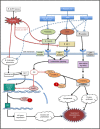The epidemiology of acne vulgaris in late adolescence
- PMID: 26955297
- PMCID: PMC4769025
- DOI: 10.2147/AHMT.S55832
The epidemiology of acne vulgaris in late adolescence
Abstract
Importance: Acne vulgaris is the most common skin condition affecting late adolescents across the globe. Although prior studies have evaluated epidemiologic patterns of acne vulgaris in various ethnicities and regions, adequate understanding of the worldwide burden of the disease associated with patients in their late adolescence (15-19-year olds) remains lacking.
Objective: To assess the global burden of the disease associated with acne vulgaris for late adolescents (15-19-year olds) and provide an overview of the epidemiology, pathophysiology, and treatment options for acne in this population.
Design: Database summary study.
Setting: Global Burden of Disease Study 2010 database.
Participants: Global Burden of Disease regions comprised countries with prevalence of acne vulgaris between the ages of 15 and 19 years.
Main outcomes and measures: Geographic region-level disability-adjusted life year rates (per 100,000 persons) associated with acne vulgaris in years 1990 through 2010. Median percentage change in disability-adjusted life year rates was estimated for each region across the specified study period.
Conclusion and relevance: Acne vulgaris-associated disease burden exhibits global distribution and has continued to grow in prevalence over time within this population. This continued growth suggests an unmet dermatologic need worldwide for this disorder and potential opportunities for improved access and delivery of dermatologic care. Our analysis of the literature reveals numerous opportunities for enhanced patient care. To that end, we highlight some of the effective and promising treatments currently available and address important factors, such as sex, nationality, genetics, pathophysiology, and diet, as they relate to acne vulgaris in late adolescence.
Keywords: GBD; diet; epidemiology; hormones; review.
Figures



References
-
- Seattle WI. GBD Compare. Seattle: University of Washington; 2013.
-
- Wolkenstein P, Grob JJ, Bastuji-Garin S, Ruszczynski S, Roujeau JC, Revuz J. French people and skin diseases: results of a survey using a representative sample. Arch Dermatol. 2003;139(12):1614–1619. discussion 1619. - PubMed
-
- Johnson MT, Roberts J. Skin conditions and related need for medical care among persons 1–74 years. United States 1971–1974. Vital Health Stat. 1978;11(212):i–v. 1–72. - PubMed
-
- Bhate K, Williams HC. Epidemiology of acne vulgaris. Br J Dermatol. 2013;168(3):474–485. - PubMed
Publication types
LinkOut - more resources
Full Text Sources
Other Literature Sources
Medical

